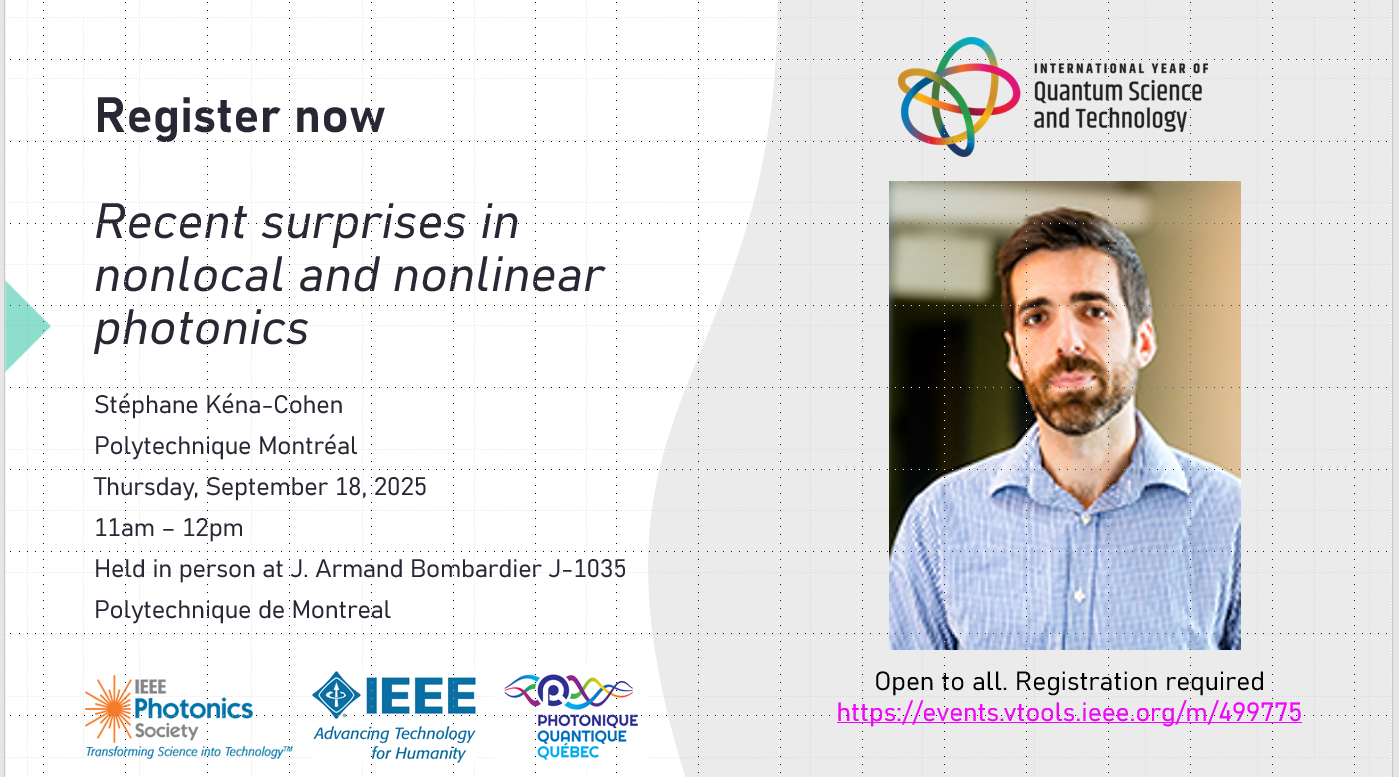Recent surprises in nonlocal and nonlinear photonics
#Quantum
#Entanglement
#PhaseEstimation
#QuantumComputing

Abstract: In this talk, we will discuss two recent observations from our group that have challenged widespread assumptions held (by us included!) about the optical response of commonly used optical materials: that material polarization can safely be considered to respond locally to the electric field and that the second-order nonlinear response of amorphous films should vanish due to centrosymmetry. In the first part of the talk, we will describe our proposal for a new type of optical antenna dubbed a “photonic gap antenna”, and our realization of its extreme version using an epsilon-near-zero (ENZ) material. Such antennas can provide electric field enhancements of >100 and large Purcell factors without requiring stringent nanofabrication. To our surprise, when measuring third harmonic generation as a proxy for field enhancement, sharp peaks emerge in the response that are completely absent in our full wave electromagnetic calculations. We find that the appearance of these peaks can only be explained when including nonlocality in the dielectric response of the ENZ material. Nonlocal simulations show that the volume averaged field enhancement can be 4–6 greater than that predicted by the local model, which becomes an important consideration when designing optical devices. In the second part of the talk, we will describe our recent discovery that amorphous thermally evaporated organic thin films of small molecules can have second-order optical nonlinearities on par with those of state-of-the-art nonlinear materials (c(2)31, c(2)33 >50 pm/V), with the important advantage that they can be deposited on arbitrary photonic platforms. We will show that by harnessing the interplay between dipole-dipole interactions and surface energy minimization, it is possible to spontaneously break centrosymmetry during thermal evaporation, without the need for special alignment procedures. In addition to its applications in photonics, this observation has allowed us to better understand molecular alignment beyond the mean molecular orientation angle.
.
Date and Time
Location
Hosts
Registration
-
 Add Event to Calendar
Add Event to Calendar
-
J. Armand Bombardier J-1035, Polytechnique Montréal
-
Montréal, Quebec
-
Canada
H3T 1J4

- Starts
05 September 2025 09:00 PM UTC
- Ends
18 September 2025 02:00 PM UTC
- No Admission Charge
Speakers
Stéphane Kéna-Cohen of Polytechnique Montréal
Topic:
Recent surprises in nonlocal and nonlinear photonics

Abstract: In this talk, we will discuss two recent observations from our group that have challenged widespread assumptions held (by us included!) about the optical response of commonly used optical materials: that material polarization can safely be considered to respond locally to the electric field and that the second-order nonlinear response of amorphous films should vanish due to centrosymmetry. In the first part of the talk, we will describe our proposal for a new type of optical antenna dubbed a “photonic gap antenna”, and our realization of its extreme version using an epsilon-near-zero (ENZ) material. Such antennas can provide electric field enhancements of >100 and large Purcell factors without requiring stringent nanofabrication. To our surprise, when measuring third harmonic generation as a proxy for field enhancement, sharp peaks emerge in the response that are completely absent in our full wave electromagnetic calculations. We find that the appearance of these peaks can only be explained when including nonlocality in the dielectric response of the ENZ material. Nonlocal simulations show that the volume averaged field enhancement can be 4–6 greater than that predicted by the local model, which becomes an important consideration when designing optical devices. In the second part of the talk, we will describe our recent discovery that amorphous thermally evaporated organic thin films of small molecules can have second-order optical nonlinearities on par with those of state-of-the-art nonlinear materials (c(2)31, c(2)33 >50 pm/V), with the important advantage that they can be deposited on arbitrary photonic platforms. We will show that by harnessing the interplay between dipole-dipole interactions and surface energy minimization, it is possible to spontaneously break centrosymmetry during thermal evaporation, without the need for special alignment procedures. In addition to its applications in photonics, this observation has allowed us to better understand molecular alignment beyond the mean molecular orientation angle.
Biography:
Short Bio: Stéphane Kéna-Cohen is a Full Professor of Engineering Physics at Polytechnique Montréal, where he heads the Light-Matter Group and is the Canada Research Chair in Light-Matter Photonics. His group works both on the development of advanced optoelectronic components and in better understanding and harnessing light-matter interaction in novel materials. His group is widely recognized for pioneering advances in understanding and exploiting the strong light-matter coupling regime in optical microcavities at room-temperature. Other recent achievements include the development of record efficiency near infrared organic light-emitting diodes, the first 2D material-based mid-infrared light-emitting diodes, the observation of superfluidity of light and the realization of photonic XY Hamiltonian lattices using polariton condensates. He obtained his PhD in 2010 as a Gordon Wu scholar at Princeton University under the supervision of Stephen R. Forrest and was a Junior Research Fellow at Imperial College London, working closely with Stefan A. Maier and Donal D.C. Bradley before joining Polytechnique Montréal.
Email:

 Add Event to Calendar
Add Event to Calendar


